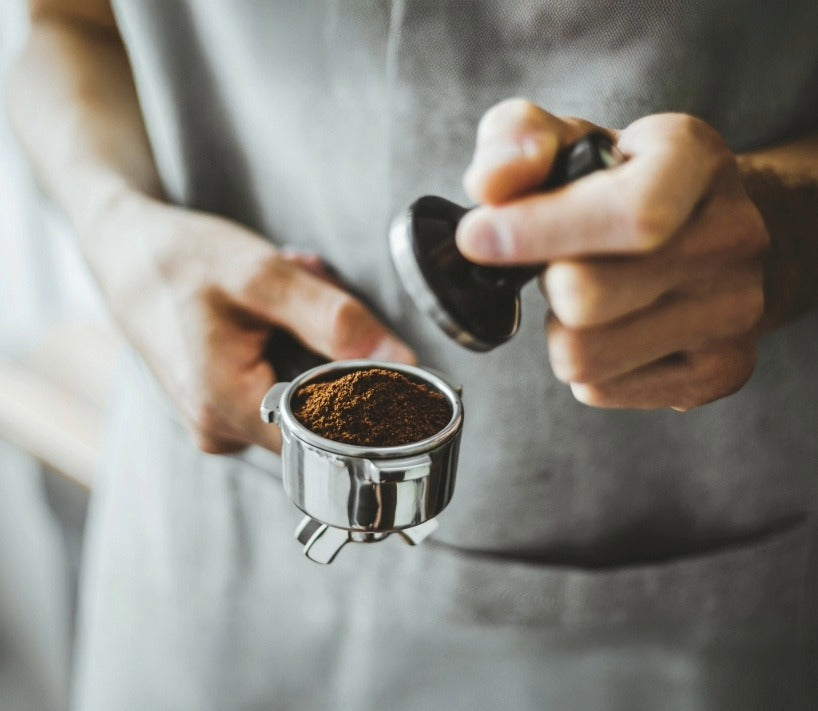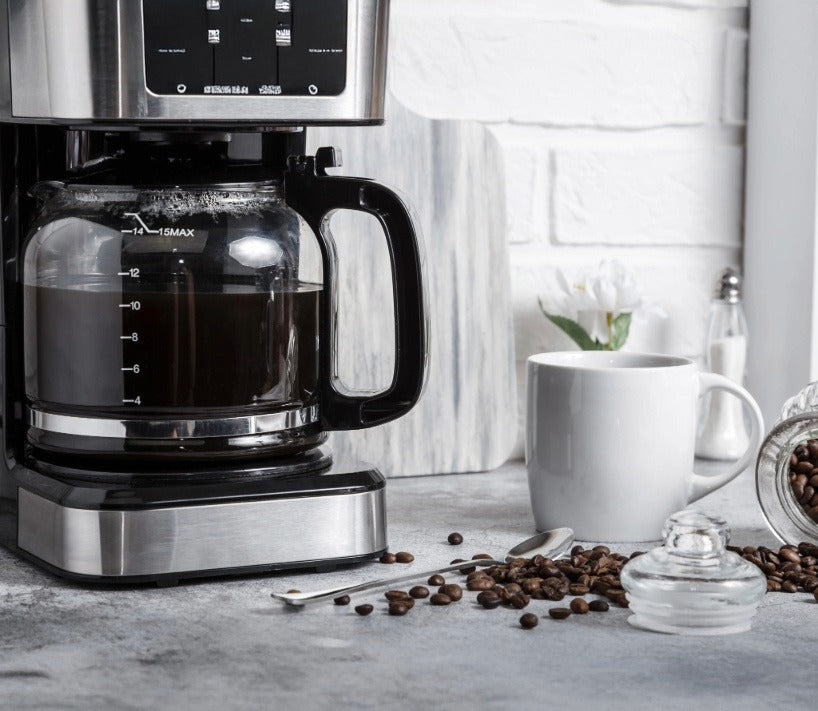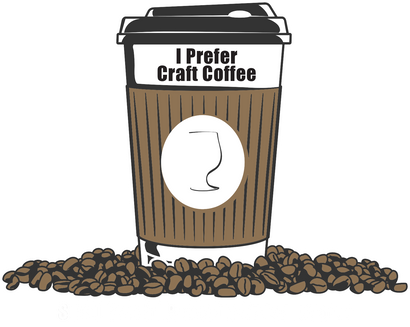Brewing vs. Buying: How Rising Top Coffee Delivered Prices Reveal Your True Java Colors
April 06, 2025 9 min read
Brewing vs. Buying: How Rising Coffee Prices Reveal Your True Java Colors
I remember the day I realized I’d been dropping a small fortune on coffee. There I was, picking up my daily latte at my favorite local café (with extra foam because, well, treat yourself, right?). As I fished out yet another ten-dollar bill—plus tip—I had a sudden flashback to that time I joked, “I should really buy my own espresso machine; it’ll be cheaper than all these lattes in the long run.” But I hadn’t followed through because convenience was my middle name, and coffee-shop culture was practically my religion.
Fast-forward to today, and everything’s getting more expensive—especially coffee. Suddenly, it’s not just my personal budget that’s complaining; entire websites and forums are abuzz with debates about whether it’s worth it to keep grabbing that pricey coffee on the go or to finally invest in brewing fresh, high-scoring specialty coffee at home. Since you’re here (and presumably as caffeine-obsessed as I am), let’s dissect this hot topic. Spoiler alert: if convenience is your jam, you’ll be forking over those seven bucks for your daily latte for the foreseeable future. But if you’re after better flavor and a little more padding in your wallet, brewing at home might be your new best friend.
1. The Jaw-Dropping Cost of Your To-Go Latte
Let’s set the stage with some simple math—no advanced calculus necessary. A standard latte (in many big cities) can run you anywhere from $5 to $7, and that’s before we start talking about specialty shots, alternative milks, or tips for your favorite barista. Multiply that by five days a week, and you’re easily spending $25 to $35 weekly. Over a month, that’s $100 to $140, and over a year, it can balloon to well over $1,200.
And for my fellow fancy drink enthusiasts who love those cinnamon-dusted, mocha-laced concoctions with the drizzle of caramel on top? You’re probably staring down an even bigger sum, especially as coffee prices creep upward. The worst part is, if you’re shelling out for that latte only because you’re addicted to convenience (and maybe the smell of freshly ground beans in a trendy café), you might never get to enjoy the more nuanced taste of truly great coffee—like the best small batch coffee or the best coffee worldwide that you might read about online.
2. The Impact of Rising Coffee Prices
Why are we even talking about this now? Because coffee prices aren’t just creeping—they’re sprinting. Various factors like weather events, changes in farming practices, labor costs, and global shipping rates can dramatically affect the cost of beans. Specialty coffee in particular, which might once have been only modestly more expensive, can start to feel like a luxury when the market gets tight.
As a result, many coffee shops—local or national chains—are forced to increase prices to keep up with overhead, wages, and ingredient costs. Even if they’re still sourcing from the best producers or offering high-scoring beans, the costs inevitably trickle down to the consumer. That morning latte might get a little pricier—or significantly pricier, depending on the region—leaving you to decide whether to suck it up or seek alternatives.
3. The Allure (and Savings) of Brewing at Home
Let’s talk about what it looks like to buy beans and whip up your own brew. While the best coffee to buy online might cost more per pound than generic supermarket beans, the difference in taste can be downright astonishing. We’re talking notes of chocolate, fruit, or caramel; think single-origin stunners from Ethiopia or Guatemala that elevate your palate beyond the standard coffee flavor profile.
Here’s the kicker: even top-of-the-line, best craft coffee at home might still cost less per cup than your daily café latte. A 12-ounce bag of high-scoring beans might cost, say, $18 to $22. If you do the math, you can usually squeeze around 20 to 25 cups of coffee out of a bag (depending on your preferred brew strength). That translates to somewhere between $0.90 and $1.10 per cup. Compare that to the $5 you’re spending on a latte, and the financial difference is astounding.
Yes, there’s an upfront investment in a decent grinder and coffee maker—whether you’re a pour-over fanatic, a French press devotee, or an espresso purist. But after those initial costs, your daily cup will be significantly cheaper. Plus, you get the satisfaction of total control. Want a more robust flavor? Adjust the grind size. Craving an extra-strong brew? Dial up the coffee-to-water ratio. No wonder some folks say this is the best craft coffee online approach—because you get to customize it to your exact preferences.
4. Flavor, Flavor, Flavor
Cost aside, let’s not forget the biggest reason many of us are obsessed with coffee: that glorious flavor. If you’re simply picking up your coffee from a generic chain, you might not even realize what you’re missing. “Bitter” is not a flavor profile, people—trust me, there’s a whole world of complexity out there.
High-scoring specialty coffee beans (sometimes found by searching “best coffee on the internet” or “where to buy gourmet coffee”) are scrutinized by professional tasters for qualities like aroma, acidity, body, and aftertaste. These coffees often come from specific regions or farms known for exemplary standards. When you brew them at home, especially soon after roasting, you’ll notice subtleties that often get lost in commercial blends—fruitiness, nuttiness, or bright floral notes.
And let’s not forget the entire ritual of making coffee at home. The aroma of freshly ground beans in the morning is practically a warm hug. If you’re an early riser who needs that cozy start to the day, investing a few minutes to brew your own coffee can feel like self-care. It’s a stark contrast to racing out the door and waiting in line for a possibly lukewarm latte that’s been sitting on the bar for five minutes while the barista juggles ten other orders.
5. The Convenience Factor
I get it. Sometimes you just can’t live without that quick, convenient caffeine fix. The local coffee shop might be on your way to work, or maybe you love the social element of chatting with the barista who already knows your go-to order. Convenience is a valid reason to keep buying coffee on the go—even if it costs more.
Brewing at home, especially in the morning, can feel like a chore if you’re half-asleep and rushing to get out the door. To mitigate that, coffee enthusiasts often prepare the night before: measure the beans, set the grinder, fill the kettle. Some even use coffee machines with built-in timers so you can literally wake up to the smell of coffee brewing. If that isn’t enough convenience for you, it might be wise to accept that the extra cost of a coffee shop latte is just part of your morning routine. After all, it’s your money.
6. High-Scoring Specialty Coffee Doesn’t Have to be Elitist
Let’s address the elephant in the room: Isn’t specialty coffee just for snobs? Absolutely not. Sure, you might see fancy terminology like “single-origin,” “natural process,” or “cupping scores.” But at its core, specialty coffee is about quality and flavor. If you’re brand-new to the coffee scene, the best way to start is to find a few beans with tasting notes that appeal to you—like chocolate, caramel, or berry undertones—and experiment.
Plenty of roasters have online shops that will roast and send you coffee as soon as you place your order, ensuring you get the freshest beans possible. That’s a far cry from picking up a bag of who-knows-how-old coffee that’s been sitting on a supermarket shelf. You can do a quick search for “where can I buy fresh coffee beans near me,” or even “buy specialty coffee online” if you’re into the idea of shipping from a boutique roaster across the country. With shipping becoming faster and more affordable, you can often get top coffee delivered in just a day or two.
If you’re overwhelmed by choice, consider snagging a small sample pack. This way, you can figure out if you prefer bright, tea-like Ethiopian coffee or the richer, chocolatey profiles of beans from Central or South America. Before you know it, you’ll be nerding out over brew ratios and “bloom” times (the part of brewing where coffee grounds release carbon dioxide and expand).
7. Brews That Satisfy Everyone’s Preferences
Let’s say you’re not the only coffee drinker in your household. Maybe one person loves strong espresso, another is a die-hard French press fan, and another wants something mild that qualifies as best coffee for non coffee drinkers. One advantage of brewing at home is you can tailor each cup, whereas a coffee shop might have limited customization options beyond syrups or milk choices.
While the café route involves scanning a menu for something that kinda matches your taste (then hoping the barista nails it), brewing at home provides more control. You want a robust dark roast? You got it. You want a light roast with fruity notes that’s a good coffee to drink black? Also doable. You like a bit of foam on top but also want to incorporate that fancy maple syrup your aunt sent you for the holidays? You can become your own barista.
8. The “Gift” of Great Coffee
Another fun perk? If you fall in love with specific beans, you can confidently recommend them as a gift for coffee lover friends or even give coffee beans as a gift for birthdays and holidays. Bonus points if you pair it with a cute mug or a simple pour-over setup for presents for coffee lovers that stand out from the usual gift cards or novelty socks. And no, you don’t have to break the bank on super-rare, best coffee worldwide types (unless you want to, of course). Even moderately priced specialty beans can feel luxurious if your friends are used to grocery-store coffee.
9. Sourcing Ethically and Sustainably
One often overlooked aspect of brewing at home is you can choose beans that align with your values, whether that means organic, Fair Trade, or direct-trade sourcing. Many local roasters pride themselves on ethical partnerships with farmers and highlight the unique origins of their beans. When you order coffee online from such roasters, you’re not just investing in great taste—you’re supporting sustainable farming practices and sometimes even local communities in coffee-growing regions.
On the other hand, large-scale café chains may have ethical sourcing guidelines, but they might not always highlight the farmers or the exact origin of their beans. If this matters to you, brewing at home offers you more control over your supply chain.
10. From “Coffee Drinker” to “Coffee Enthusiast”
There’s a subtle but profound shift that happens when you start making high-quality coffee at home. You evolve from a passive consumer to an active participant in the coffee experience. You start paying attention to water temperature, grind size, and brew time. It’s a hobby that can be as simple or as elaborate as you want it to be.
Sure, you might still pop into your favorite shop occasionally to chat with the friendly baristas or pick up a latte on a hectic morning. But once you realize that your kitchen can produce cups that rival (or exceed) what you get on the go, it’s hard to go back to blindly accepting that daily seven-dollar hit to your wallet.
So, here we are, at the crossroads. Coffee prices are on the rise, and you’re left weighing your options: do you keep paying the new-and-improved latte costs at your local (or national) chain, or do you invest time (and a bit of upfront cash) into brewing a fantastic cup at home using high-quality beans?
If you’re someone who values convenience above all else, no judgment—maybe that coffee shop pit stop is part of your daily ritual, and you can’t imagine life without it. That’s okay; just be prepared to keep forking over those extra dollars as coffee prices inch upward.
But if you crave deeper flavor, you want the chance to taste the best tasting whole bean coffee, you’re willing to learn the basics of brewing, and saving money on your caffeine habit is appealing, it’s worth making the switch. When you buy specialty coffee online or find a roaster “where can I buy fresh coffee beans near me,” you open the door to a world of tasting experiences you might never encounter at a standard café. And in many cases, you’ll end up spending less per cup once you’ve covered the cost of your brewing gear.
Beyond the cost and flavor benefits, brewing coffee at home can become a cherished morning ritual—one that’s simultaneously calming and invigorating. There’s just something about the scent of freshly ground beans filling your kitchen as you prepare the perfect pour-over or your favorite French press. Once you taste the difference, you might wonder why you ever settled for anything less.
Of course, the beauty of coffee culture is there’s no one-size-fits-all approach. If you’re a social butterfly who loves the café atmosphere, keep going! Maybe you’ll find a happy middle ground—picking up a latte a couple of days a week and brewing the rest of the time. Or if you’re like me, you’ll start brewing at home so frequently that your barista wonders where you’ve disappeared to.
But, hey, coffee is personal. It’s a daily comfort, a treat, a tradition. All I’m saying is that when coffee prices head north, don’t forget you have a choice. You can embrace café life—or you can become the barista of your own domain, exploring the spectrum of coffee flavors whenever you want. My bet? Once you get a taste of truly fresh, high-scoring beans brewed just how you like them, you’ll be reluctant to go back to the pricey chain cappuccinos (except for the occasional social outing, of course).
At the end of the day, your wallet and your taste buds will likely agree that taking a bit of time to explore the home-brewing route is absolutely worth it. Unless, of course, you really can’t live without that latte art done by your barista crush every morning. In that case, brew on, friend—or buy on, whichever you prefer. After all, life’s too short not to enjoy your coffee exactly how you want it.
Also in Best Coffee To Buy Online Education

Best Craft Coffee For Espresso at Home: Why FullCity+ Wins
December 30, 2025 3 min read
Learn why medium/dark FullCity+ roasts deliver the best espresso at home without bitterness. When you order coffee online from a roaster you trust, you'll always end up with the best tasting craft coffee at home.

Best Coffee Beans for Drip Coffee (Yes, Any Roast Works)
December 29, 2025 3 min read
Best Coffee Beans for Drip Coffee. A simple guide explaining how any roast profile works with drip coffee makers when using fresh specialty coffee.

Top Rated Coffee Beans for Pour Over (Fresh Wins)
December 28, 2025 3 min read
Top Rated Coffee Beans for Pour Over (Fresh Wins)
A simple guide to choosing the best tasting craft coffee at home - fresh, single origin coffee beans online that make pour over coffee taste amazing at home.
